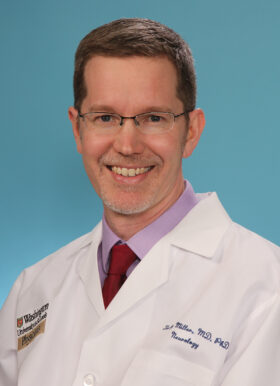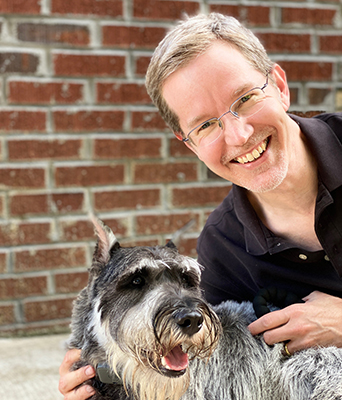Timothy Miller, MD, PhD

Dr. Timothy Miller is a neurologist who specializes in ALS and other neurological disorders.
Dr. Miller sees patients at:
Center for Advanced Medicine
Neuroscience Center, Suite 6C
4921 Parkview Place
St. Louis, MO 63110
Please call 314-362-6981 for an appointment.
What happened in the course of schooling to influence you to choose your specialty?
I am a neurologist with an MD, PhD – and a concentration in neuroscience for my PhD. As I tried out a number of specialties in medical school, I realized I really liked solving the problems associated with neurologic diseases. That was the main reason I chose my specialty.
As a physician taking care of patients with neurologic disorders, I recognized the puzzles that were most interesting and the patient group I really enjoyed working with were those with neuromuscular diseases.
While I was completing my neuromuscular fellowship at the University of California-San Francisco (UCSF), I discovered I enjoyed taking care of patients with ALS. I recognized the enormous need to find therapies to help that patient group and was attracted to studying ALS because I thought I could have an impact on new ways to treat ALS.

What brought you to Washington University?
This was an outstanding opportunity to be part of a top-notch neurology department, clinical group and research environment that focused on treating patients with neurodegenerative diseases.
Which aspect of your practice do you find most interesting?
The most interesting part of my practice is trying to figure out what causes ALS and how to develop therapies for ALS.
I listen carefully to our patients and think deeply about what could be causing their ALS and what new therapies would help them.
I would say one of the most interesting parts of a disease like ALS, is that some neurons are affected and some are not. For example, the neurons that move your face or your arms and legs can be affected, and other neurons that move the eyes are not affected.
Embedded within that observation is a super important clue as to what is causing ALS and how to treat ALS. We have not yet been able to unlock that clue, but hopefully some day we will be able to.
What research are you involved with at the moment?
Eighty-five percent of my time is spent on research — both clinical trials for new therapies with ALS patients and basic science research in the wet lab – trying to understand what causes the disease and developing new therapies.
There are a number of therapies in early phase clinical trials that are promising for ALS – some of them with exciting results. What we need now are the larger Phase III trials to show clearly whether a drug works.
One of the clinical trials we are most excited about, and one I’ve been working on for many years, is a way to lower the level of a gene product, SOD1 — a gene that causes familial ALS (genetic forms of ALS). Using a type of drug called antisense oligonucleotide, it appears to have had an impact in a small trial on those people with SOD1-related ALS.
It’s the beginning of a new way to treat genetic forms of ALS. We hope that will also translate into new ways to treat all forms of ALS. About 90% of ALS has an unknown genetic cause, and about 10% is caused by a gene.
How do you have the initial conversation to tell a patient that he or she has ALS?
I trained with Dr. Rick Olney, an ALS clinician at UCSF, he was my first mentor who dedicated his life to studying ALS. Tragically, he developed ALS and died in 2012.
When taking care of patients with ALS, one of the first things Dr. Olney asked was what the patient understood and what he or she had learned so far about what was going on. That approach helps to gauge where the patient is at the moment.
Many patients who come to our clinic have been told they have ALS, and so we are not the first to bring that up. Others have heard it mentioned, but don’t really know anything about it. Others have not been told anything at all, and have no idea that that’s the disease they may have.
Only after I take the first step in determining where the patient is, can I start the discussion about what his or her diagnosis might be.
From there the conversation continues at different levels. It is never an easy conversation, but it is an important one that takes time in order to help me understand where the patient is in this journey to his or her diagnosis.
We take the time to talk about what is happening, and at the same time explaining the interventions, therapies, services and support that are available through our clinic.
Where are you from?
I grew up in St. Louis, went to University of Virginia for undergraduate training, and came back to St. Louis to complete my MD, PhD at Washington University. I left for California to do my neurology and neuromuscular fellowship at the University of California-San Francisco (UCSF). My basic science training continued with a post-doctoral fellowship at the University of San Diego. I was in California for about a decade, and came back here in 2007.
Is there a particular award or achievement that is most gratifying?
I was very pleased to receive the Sheila Essey Award for ALS Research. It is one of the most recognized awards within the ALS research space and it was very gratifying to accept it on behalf of my group and the work that we have been doing.
What is the best advice you’ve received?
One piece of advice I’ve received is when things are going well, make sure to step back, recognize it and enjoy the moment. Because there will be times when things aren’t going well, and it is very easy to quickly forget the good news. So when the news is good, we need to pause and remember it.
The other piece of advice came from a variety of sources and in different ways. This advice was to make sure you put your energy, thoughts and time into something you find interesting and satisfying. This is the key to maintaining a level of high productivity while keeping your job enjoyable.
If you weren’t a doctor, what would you like to be doing?
I didn’t have a back-up plan. I headed towards science and medicine and just kept going along that path. I had many wide interests in undergraduate, so I’m sure I would have been happy doing a variety of things, I just didn’t have a plan B.
Do you have time for any hobbies?
In college, I enjoyed studying French. I spent a lot of time and effort learning French, and also spent time studying and doing research in France.
The other hobby that I very much enjoy, but I bring no talent to, is playing guitar.
I also enjoy different forms of exercise. I really like biking and I love mountain biking. I’m on my bike frequently, even when it is cold. I biked a lot when I lived in California, in the city and the mountains. I have since discovered that Missouri has many great places to bike, as well. However, none as challenging as navigating the streets and trolley tracks of San Francisco!